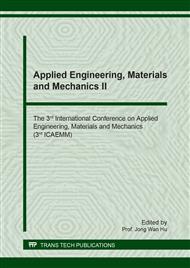[1]
J. S. Kim, D. H. An, S. Y. Lee, and B. Y. Lee, A failure analysis of fillet joint cracking in an oil storage tank, J. Loss Prevent. Proc. Ind. 22 (2009) 845-849.
DOI: 10.1016/j.jlp.2009.08.014
Google Scholar
[2]
J. W. Fernandez, P. W. Cleary, and W. McBride, Effect of screw design on hopper drawdown of spherical particles in a horizontal screw feeder, Chem. Eng. Sci. 66 (2011) 5585-5601.
DOI: 10.1016/j.ces.2011.07.043
Google Scholar
[3]
D. Deng, W. Liang, and H. Murakawa, Determination of welding deformation in fillet-welded joint by means of numerical simulation and comparison with experimental measurements, J. of Mater. Proc. Tech. 183 (2007) 219-225.
DOI: 10.1016/j.jmatprotec.2006.10.013
Google Scholar
[4]
J. W. Hu, Response of Seismically Isolated Steel Frame Buildings with Sustainable Lead-Rubber Bearing (LRB) Isolator Devices Subjected to Near-Fault (NF) Ground Motions. Sustain. 7 (2015) 111-137.
DOI: 10.3390/su7010111
Google Scholar
[5]
J. W. Seo, Y. C. Kim, J. W. Hu, Pilot Study for Investigating the Cyclic Behavior of Slit Damper Systems with Recentering Shape Memory Alloy (SMA) Bending Bars Used for Seismic Restrainers, Appl. Sci. 5(3) (2015) 187-208.
DOI: 10.3390/app5030187
Google Scholar
[6]
K. Kimapong and T. Watanabe, Friction Stir Welding of Aluminum Alloy to Steel, Weld. J. 84 (2004) 277s-282s.
Google Scholar
[7]
G. Fu, M. I. Lourenco, M. Duan, and S. F. Estefen, Effect of boundary conditions on residual stress and distortion in T-joint welds, J. Constr. Steel Res. 102 (2014) 121-135.
DOI: 10.1016/j.jcsr.2014.07.008
Google Scholar
[8]
G. Fu, M. I. Lourenço, M. Duan, and S. F. Estefen, Influence of the welding sequence on residual stress and distortion of fillet welded structures, Marine Struct. 46 (2016) 30-55.
DOI: 10.1016/j.marstruc.2015.12.001
Google Scholar
[9]
J. Yi, et al., Effect of welding current on morphology and microstructure of Al alloy T-joint in double-pulsed MIG welding, Trans. Nonf. Met. Soc. China 25 (2015) 3204-3211.
DOI: 10.1016/s1003-6326(15)63953-x
Google Scholar
[10]
M. M. A. Khan, L. Romoli, M. Fiaschi, G. Dini, and F. Sarri, Laser beam welding of dissimilar stainless steels in a fillet joint configuration, J. Mater. Proc. Tech. 212 (2012) 856-867.
DOI: 10.1016/j.jmatprotec.2011.11.011
Google Scholar
[11]
S. Liu, G. Mi, F. Yan, C. Wang, and P. Jiang, Correlation of high power laser welding parameters with real weld geometry and microstructure, Opt. & Laser Tech. 94 (2017) 59-67.
DOI: 10.1016/j.optlastec.2017.03.004
Google Scholar
[12]
M. Cerit, K. Hosgor, and A. O. Ayhan, Fracture mechanics-based design and reliability assessment of fillet welded cylindrical joints under tension and torsion loading, Eng. Fract. Mech. 116 (2014) 69-79.
DOI: 10.1016/j.engfracmech.2013.11.019
Google Scholar
[13]
D. R. Askeland and P. P. Phule, The Science and Engineering of Materials, Thompson Canada Limited, Toronto, (2006).
Google Scholar
[14]
P. Poonnayom, S. Chantasri, J. Kaewwichit, W. Roybang, and K. Kimapong, Microstructure and Tensile Properties of SS400 Carbon Steel and SUS430 Stainless Steel Butt Joint by Gas Metal Arc Welding, Inter. J. Adv. Cult. Tech. 3 (2015) 61-67.
DOI: 10.17703/ijact.2015.3.1.61
Google Scholar
[15]
Y. Wu, Y. Cai, H. Wang, S. Shi, X. Hua, and Y. Wu, Investigation on microstructure and properties of dissimilar joint between SA553 and SUS304 made by laser welding with filler wire, Mater. Des. 87 (2015) 567-578.
DOI: 10.1016/j.matdes.2015.08.076
Google Scholar
[16]
R. A. Jeshvaghani, E. Harati, and M. Shamanian, Effects of surface alloying on microstructure and wear behavior of ductile iron surface-modified with a nickel-based alloy using shielded metal arc welding, Mater. Des. 32 (2011) 1531-1536.
DOI: 10.1016/j.matdes.2010.10.006
Google Scholar
[17]
M. F. Buchely, J. C. Gutierrez, L. M. León, and A. Toro, The effect of microstructure on abrasive wear of hardfacing alloys, Wear 259 (2005) 52-61.
DOI: 10.1016/j.wear.2005.03.002
Google Scholar
[18]
R. Zahiri, R. Sundaramoorthy, P. Lysz, and C. Subramanian, Hardfacing using ferro-alloy powder mixtures by submerged arc welding, Surf. Coat. Tech. 260 (2014) 220-229.
DOI: 10.1016/j.surfcoat.2014.08.076
Google Scholar
[19]
P. F. Mendez, N. Barnes, K. Bell, S. D. Borle, S. S. Gajapathi, S. D. Guest, Welding processes for wear resistant overlays, J. Mater. Proc. Tech. 16 (2014) 4-25.
DOI: 10.1016/j.jmapro.2013.06.011
Google Scholar
[20]
X. H. Wang, F. Han, X. M. Liu, S. Y. Qu, and Z. D. Zou, Effect of molybdenum on the microstructure and wear resistance of Fe-based hardfacing coatings, Mater. Sci. and Eng.: A, 489 (2008) 193-200.
DOI: 10.1016/j.msea.2007.12.020
Google Scholar
[21]
C. M. Lin, C. M. Chang, J. H. Chen, and W. Wu, The effects of additive elements on the microstructure characteristics and mechanical properties of Cr–Fe–C hard-facing alloys, J. Alloy. Comp. 498 (2010) 30-36.
DOI: 10.1016/j.jallcom.2010.03.127
Google Scholar


